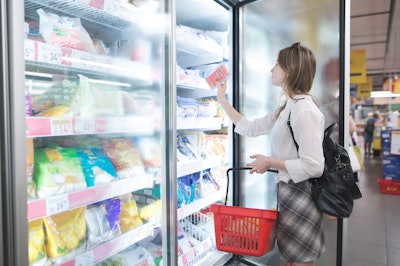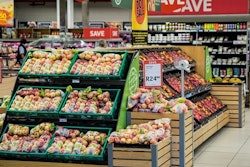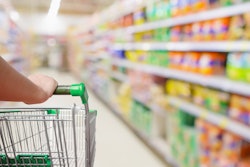
The COVID-19 pandemic is driving an explosion in grocery ecommerce that may transform the industry – and give retail grocers a leg up in their fight against Amazon and other ecommerce giants, according to global management consulting firm L.E.K. Consulting.
In response, grocers are radically revamping their stores and strategies to meet a dramatically different kind of consumer demand. The new approach – which shifts store space from retail shelves to automated micro-fulfillment centers that support curbside pickup – could lead to a lasting shift in the industry’s economics. That is in part because consumers take on responsibility for the “last mile” of home delivery, removing a big expense that brick-and-mortar grocers can cut but Amazon and its online competitors have to bear. It also provides next-hour convenience that online grocers have so far been unable to match.
The promise of micro-fulfillment, and its likely impact on the post-COVID-19 grocery industry, is the subject of Micro-Fulfillment Centers for Grocery: How Thinking Small Can Be a Big Win, a new report just published by L.E.K. Consulting. The report details the impact of the ecommerce boom on an industry known for its razor-thin margins.
Large numbers of grocery consumers are shifting to e-commerce
According to the report, consumers worried about COVID-19 have turned to same-day ecommerce ordering in huge numbers. The number of U.S. households using online grocery services has more than tripled – from 16 million (13% of US households) in August 2019 to 46 million (35% of US households) last June. While the trend to online grocery shopping was underway, without COVID-19, it would have taken three to five years to reach this level of penetration.
Figures from leading grocery retailers confirm surging demand. “Target has recorded over 700 percent growth in curbside. Walmart reports 100 percent growth from a much bigger base – about $100 billion quarterly,” said Rob Wilson, an L.E.K. managing director and a co-author of the report. “The ecommerce numbers are just tremendous.”
E-commerce and curbside pickup are the future of grocery
“We see ecommerce and curbside pickup as the future of grocery,” Wilson said. “Grocery retailers are going to want to push consumers to go to curbside because they want their footprint to stay relevant, and they want the consumer to eat the cost of the last mile rather than their having to pay for it.”
“Right now, groceries are trying to adapt, but it’s an inefficient system, with staff walking up and down the aisles to assemble orders,” Wilson continued. “This is not sustainable from an operating margins standpoint. So to address that, they’ve started installing micro-fulfillment centers within grocery stores to automate the picking. And that’s extremely interesting. If operating expenses become much lower because, with digital ordering instead of cashiers, and robots instead of manual picking and restocking the shelves, that could change the financial picture of a grocery store if it is a significant chunk of its volume.
“It gives you a potential advantage against Amazon and other ecommerce giants that have not yet solved the challenge of same-day grocery delivery. And some consumers view curbside pickup at a time they choose as more convenient than groceries being dropped at your front door when out and about,” Wilson said.
Grocers are moving fast to transform their stores to set up micro-fulfillment centers
Grocers of all sizes – but especially large ones – are converting store space to micro-fulfillment or are building dedicated micro-fulfillment “dark stores” without any retail space. “It’s mainly the big stores that are doing it right now, like Kroger and Walmart,” Wilson explained. “In Walmart’s latest $4 billion expansion into Canada, all of them have micro-fulfillment centers. But there is interest across the board. We’ve spoken with single-site grocers who want to set up micro-fulfillment.”
Micro-fulfillment cuts costs but threatens profits – grocers must find a balance
Grocers considering a move into micro-fulfillment need to understand what’s different compared to traditional retail shopping, and act to protect profitability, the report says.
“Grocers should consider both the cost and the basket,” said Shang Saavedra, an L.E.K. engagement manager and a report co-author. “On the cost side, micro-fulfillment allows grocers to recapture fees from services like Instacart. And they can reduce inefficiencies in picking and packing compared to a situation in which store associates have to shop retail shelves.
“Costs matter because ecommerce baskets are less profitable today – they are more likely to consist of bulk and staple items,” Saavedra continued. “And ecommerce consumers are less likely to discover and buy new brands. Added fees from concierge providers like Instacart or added operating expenses from manual picking hurt margins – all of that counts against higher-margin baskets and more efficient fulfillment solutions.”
“In spite of these challenges, grocery ecommerce enables grocers to keep the sale – and that is preferable to losing it to Amazon,” Saavedra said.
Advice to grocers considering micro-fulfillment: act fast
For grocers considering micro-fulfillment, time is of the essence, Wilson said. “The time to act is now. The technology is available. This does require up front capital expenditures, but can change operating margins over the long term.”
As micro-fulfillment accelerates pre-pandemic trends toward ecommerce, “there is little doubt that retail grocery spaces are going to undergo significant transformation. Reduced operating expenses through increased automation could create a steady state of higher margins over the long term,” Wilson said.



















